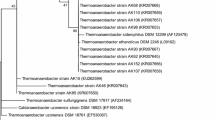Summary
Clostridium thermosaccharolyticum can produce up to 40 mM butanol. The formation of ethanol and butanol from starch and glucose by strain DSM 571 and by the new isolate 021 was compared. The ratios for ethanol/acetate and butanol/butyrate were higher during growth at neutral pH than at acidic pH. Butanol formation was greatly stimulated by the addition of butyrate.
Similar content being viewed by others
Literature
Afschar, A.S., H. Biebl, K. Schaller and K. Schügerl. (1985). Eur. J. Appl. Microbiol. Biotechnol. 22, 394–398.
Bahl, H., W. Andersch and G. Gottschalk. (1982). Eur. J. Appl. Microbiol. Biotechniol. 15, 201–205
Bahl, H., M. Gottwald, A. Kuhn, V. Rale, W. Andersch and G. Gottschalk. (1986). Appl. Environ. Microbiol. 52, 169–172.
Bryant, M.P. (1972). Am. Clin. Nutr. 25, 1324–1328.
George, H.A. and J.S. Chen. (1983). Appl. Environ. Microbiol. 46, 321–327.
Gottschal, J.C. and J.G. Morris. (1982). Biotechnol. Lett. 4:477–482.
Häggström L. and S.O. Enfors. (1982). Appl. Biochem. Biotechnol. 7, 35–37.
Hartmanis, M.G.N. and S. Gatenbeck. (1984). Apl. Environ. Microbiol. 47, 1277–1283.
Hoffmann, J.W., E.K. Chang and E.J. Hsu. (1978). Spores VIII, 312–318.
Holdeman, L.V., E.P. Cato and W.E.C. Moore. (1977). Anaerobe Laboratory Manual, 4th ed., Blacksburg, Virginia.
Jain et al. (1988). Int. J. Sys. Bacteriol. 38, 179–182.
Lee, C.K. and Z.J. Ordal. (1967). J. Bacteriol. 94, 530–536.
Miller, G.M., R. Blum, W.E. Glennon and A.L. Burton (1960). Anal. Biochem. 1, 127–132.
Monot, F., J.M. Engasser and H. Petitdemange. (1983). Biotechnol. Bioeng. Symp. 13, 207–216.
Pennig, N. and K.D. Lippert. (1966). Arch. Mikrobiol. 55, 245–256.e
Sukkumarvasi et al. (1988). Int. J. Sys. Bacteriol. 38, 179–182.
Upton, M.E. and W.M. Fogarty. (1977). Appl. Environ. Microbiol. 33, 59–64.
Wiegel, J. (1980). Experientia 36, 399–424.
Wiegel, J., S.-U. Kuk and G.W. Kohring. (1989). Int. J. Sys. Bacteriol. 39, 199–204.
Wiegel, J. and L.G. Ljungdahl. (1986). CRC Crit. Rev. Biotechnol. 3, 39–108.
Wolin, E.A., R.S. Wolfe and M.J. Wolin. (1964). J. Bacteriol. 87, 993–998.
Wood, H.G., R.-W. Brown and C.H. Werkman. (1945). Arch. Biochem. 62, 243–260.
Zeikus, J.G. (1979). Ann. Rev. Microbiol. 34, 423–464.
Author information
Authors and Affiliations
Rights and permissions
About this article
Cite this article
Freier-Schröder, D., Wiegel, J. & Gottschalk, G. Butanol formation byClostridium thermosaccharolyticum at neutral pH. Biotechnol Lett 11, 831–836 (1989). https://doi.org/10.1007/BF01026107
Issue Date:
DOI: https://doi.org/10.1007/BF01026107




